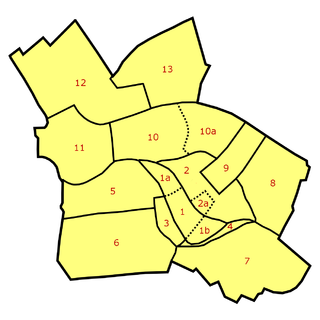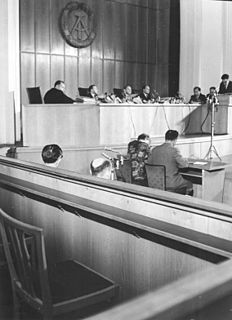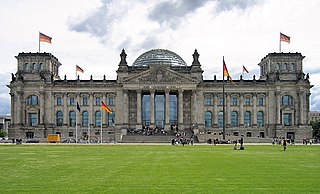
Mönchengladbach is a city in North Rhine-Westphalia, Germany. It is located west of the Rhine, halfway between Düsseldorf and the Dutch border.
The Federal Court of Justice is the highest court in the system of ordinary jurisdiction in Germany, founded in 1950. It has its seat in Karlsruhe with two panels being situated in Leipzig since 1997 and 2020, respectively. It is the supreme court in all matters of criminal law and private law. A decision handed down by the BGH can be reversed only by the Federal Constitutional Court of Germany in the rare cases that the Constitutional Court rules on constitutionality.

Moabit is an inner city locality in the borough of Mitte, Berlin, Germany. As of 2016, around 77,000 people lived in Moabit. First inhabited in 1685 and incorporated into Berlin in 1861, the former industrial and working-class neighbourhood is fully surrounded by three watercourses which define its present-day border. Between 1945 and 1990, Moabit was part of the British sector of West Berlin that directly bordered East Berlin.

Schöneberg is a locality of Berlin, Germany. Until Berlin's 2001 administrative reform it was a separate borough including the locality of Friedenau. Together with the former borough of Tempelhof it is now part of the new borough of Tempelhof-Schöneberg.

Cölln was the twin city of Old Berlin (Altberlin) from the 13th century to the 18th century. Cölln was located on the Fisher Island section of Spree Island, opposite Altberlin on the western bank of the River Spree, until the cities were merged by Frederick I of Prussia to form Berlin in 1710. Today, the former site of Cölln is the historic core of the modern Mitte locality of the Berlin-Mitte borough in central Berlin.
Franz Reinhold Schwede was a Nazi German politician, Oberbürgermeister of Coburg and both Gauleiter and Oberpräsident of Pomerania. An early supporter of Adolf Hitler in Coburg, Schwede used intimidation and propaganda to help elect the first Nazi-majority local government in Germany. This contributed to a personality cult surrounding Schwede and he became known as "Franz Schwede-Coburg." During World War II he ordered secret executions of the infirm and mass deportations of Jews. He also played a key role in abandoning the Pomeranian civilian population to the advancing Red Army, while escaping their fate himself. In 1945 he was captured by the British Army and in 1948 he was tried and convicted of war crimes.

Leipziger Straße is a major thoroughfare in the central Mitte district of Berlin, capital of Germany. It runs from Leipziger Platz, an octagonal square adjacent to Potsdamer Platz in the west, to Spittelmarkt in the east. Part of the Bundesstraße 1 highway, it is today one of the city's main east–west road links.

Adolf Arndt was a German politician of the Social Democratic Party (SPD) and former member of the German Bundestag.

The Supreme Court of the German Democratic Republic was the highest judicial organ of the GDR. It was set up in 1949 and was housed on Scharnhorststraße 6 in Berlin. The building now houses the district court in Berlin, Germany 2 Instance and the District Court Berlin-Mitte. In the early days, 14 judges made up the court.

The Admiralspalast is a 1,756-seat theatre on Friedrichstraße in the Mitte district of Berlin, Germany. Opened in 1910, it is one of the few preserved variety venues of the pre-World War II era in the city.

The Kammergericht (KG) is the Oberlandesgericht, the highest state court, for the city-state of Berlin, Germany. As an ordinary court according to the German Courts Constitution Act (Gerichtsverfassungsgesetz), it deals with criminal and civil cases, superior to the local Amtsgerichte and the Landgericht Berlin. Its name differs from other state courts for historic reasons; it is the only court called Kammergericht in Germany.

Jerusalem Church is one of the churches of the Evangelical Congregation in the Friedrichstadt, a member of the Protestant umbrella organisation Evangelical Church of Berlin-Brandenburg-Silesian Upper Lusatia. The present church building is located in Berlin, borough Friedrichshain-Kreuzberg, in the quarter of Friedrichstadt. Jerusalem Church is fourth in rank of the oldest oratories in the town proper.

Marwa Ali El-Sherbini, was an Egyptian woman and German resident who was killed in 2009 during an appeal hearing at a court of law in Dresden, Germany. She was stabbed by Alex Wiens, an ethnic German immigrant from Russia against whom she had testified in a criminal case for verbal abuse. El-Sherbini's husband, who was present at the hearing, tried to intervene. He too was repeatedly stabbed by Wiens and was then mistakenly shot and wounded by a police officer who was called to the court room. Wiens was arrested at the crime scene and subsequently tried for murder and attempted murder. He was found guilty of both charges; it was also found that Wiens's actions constituted a heinous crime, because they were committed in front of a child, against two people, in a court of law, and fulfilled the murder criterion of treacherousness, such as hatred against foreigners. Wiens was sentenced to life imprisonment.
Erna Scheffler, born Friedental and later Haßlacher was a German senior judge.

The Maxim Gorki Theatre is a theatre in Berlin-Mitte named after the Soviet writer, Maxim Gorky. In 2012, the Mayor of Berlin Klaus Wowereit named Şermin Langhoff as the artist director of the theatre.

Platz der Republik is a square in Berlin, Germany. It is located in the Tiergarten, directly in front (west) of the Reichstag building. The square has an area of about 36,900 square meters and is almost completely covered by grass but is decorated with some hedges and a few trees.

Molkenmarkt is the oldest square in Berlin. It is located in the Alt-Berlin quarter of the Mitte district, in the historic centre of the city. With approximately 9,200 square metres (11,000 sq yd) in size, it is today a major traffic junction, dominated by the large Altes Stadthaus administrative building on its southeastern side.

The Märkisches Museum is a museum in Mitte, Berlin. Founded in 1874 as the museum of the city of Berlin and its political region, the March of Brandenburg, it occupies a building on the northern edge of Köllnischer Park, facing the Spree, which was designed by Ludwig Hoffmann and completed in 1908. It is now the main facility of the Stiftung Stadtmuseum Berlin, Landesmuseum für Kultur und Geschichte Berlins, the City of Berlin museum foundation, which also operates four other sites.

Josef Michael Hartinger was a German lawyer who worked for the Bavarian State authorities in the latter years of the Weimar Republic when the Nazis came to power. Tasked with investigating some unnatural deaths at the Dachau concentration camp near Munich, Hartinger together with his medical examiner colleague, Moritz Flamm, discovered the SS policy of summary executions and faked suicides at the camp. At great risk to his own safety, Hartinger issued an indictment of the camp authorities, which was ultimately betrayed and suppressed.

The Moabit Criminal Court the central criminal court of Berlin, Germany, located in the district of Moabit. It is the largest criminal court in Europe with 340 judges and 360 prosecutors. It's part of the Berlin's Landgericht.


















